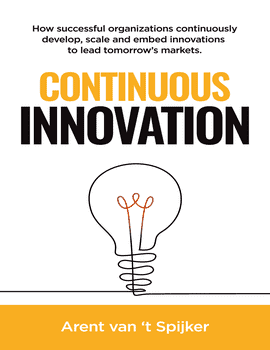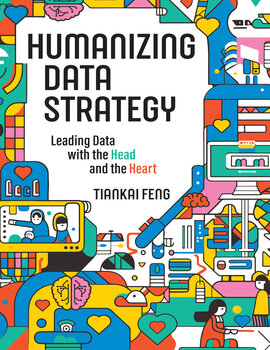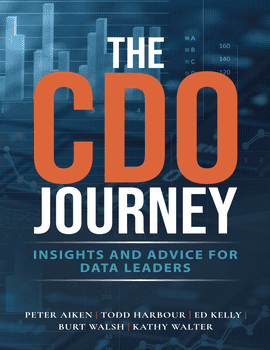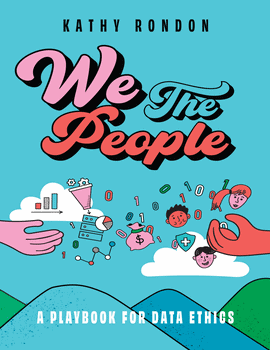Continuous Innovation
Continuous Innovation: How successful organizations continuously develop, scale, and embed innovations to lead tomorrow’s markets, by Arent van ‘t Spijker
Learn about the new paradigm in corporate innovation through a clear model backed by real world case studies.
Topics
CHAPTER 1: The Times are Changing
Innovative, yet reluctant to change
Competition from technology
Bowler hats and hoodies
CHAPTER 2: Why You Should Read This Book
PART I: Creative Destruction and Disruptive Innovation
CHAPTER 3: The Increasing Speed of Disruption
Schumpeter’s creative destruction
Christensen’s disruptive innovation
Continuous innovation
Innovation self-assessment
CHAPTER 4: Continuous Change
Three value drivers for data
1. Analysis for performance optimization
2. New products and services
3. Innovative solutions and new business models
Beyond Ansoff
Beyond an investment strategy
McKinsey’s Three Horizons Framework
McGrath’s Opportunity Portfolio Matrix
HBR’s Adjacency Matrix
A strategy for investment, speed, and change
CHAPTER 5: The Corporate Catch-22
The paradox of asset-centric business models
Incumbents protect past investments
Incumbents improve efficiency, not adaptability
Incumbents assimilate acquisitions, they do not adapt to them
Incumbents undervalue digital, data-driven markets
All dressed up and nowhere to go
Corporations own and control large markets
Corporations leverage well-trained workforces
Corporations have deep pockets
Corporations own steady streams of data
“It’s life, Jim, but not as we know it”
PART II: Three Plateaus of Innovation Strategy
CHAPTER 6: Innovation Strategy Matrix
Revolution: Rapid evolution
Three plateaus of innovation strategy
Plateau 1: Optimize
Plateau 2: Transform
Plateau 3: Innovate
Datafication’s gravitational pull
CHAPTER 7: Plateau 1: Optimize
Key principles of Plateau 1
Innovations reinforce existing targets
Successful innovations over-optimize
Success creates managerial distance from innovation
UPS: Right hand turns only
CHAPTER 8: Plateau 2: Transform
Plateau 2 and the ‘glass ceiling’
Key principles of Plateau 2
Processes and KPIs change
Silos will break
Multidisciplinary teams will be required
Plateau 2 is the magnet for change
CHAPTER 9: Plateau 3: Innovate
Key principles of Plateau 3
Service trumps production
Platform trumps product
Platforms operate a two-sided business model
Platforms increase value of physical assets
Platforms leverage success of competitors
Data structure trumps organizational structure
Speed trumps efficiency
Installed base trumps everything
CHAPTER 10: Moving Through the Plateaus
Innovation self-assessment Part II
The inefficiency zone
The disruption zone
The organizational change hurdle
Stick to Plateau 1 and move up
Jump to Plateau 3 and leverage size
Iterative development through Plateau 1, 2 and 3
Developing a roadmap
Start with a vision
One step at a time
The importance of the next best step
Technology learnings
Market learnings
Organization learnings
We shape our tools, then they shape us
CHAPTER 11: Innovation’s Omnipresence
Two identifiable changes
Datafication pushes economic value forward
Services are always at the front of the value chain
Data drives focus on customer experience
Datafication pushes innovation down into the market
Competition starts between Plateau 2 and Plateau 3
Plateau P+1
PART III: Creating Continuity
CHAPTER 12: Balancing Concerns
Existing vs. requisite capabilities
Product vs. process innovation
Internal vs. external cooperation
Control vs. flexible governance
CHAPTER 13: The Ambidextrous Organization
Different speeds for different processes
Different mindsets and cultures
Scaling up is hard to do
Merging the two flows
Technology architecture
Competencies
Processes
Partnerships
Reinventing KPIs
The importance of non-financial metrics
The need for rapid iteration
CHAPTER 14: Agility Matters
Agility is not optional
Iteratively develop products and services
Work in multidisciplinary teams
Replace plans with planning
CHAPTER 15: Continuous Innovation
Continuous innovation as a core competence
The Continuous Innovation Framework
Ideation and ownership
Validation
Experimentation
Scaling
Embedding
The definition of success is ‘flow’
Continuous Innovation offers a novel idea in corporate strategy: innovation as a core competence; a continuous process with predictable timelines and outcomes. It offers the Why, the What, and the How of this new paradigm in corporate innovation. It is a guidebook that helps leaders in corporate organizations increase their competitive strength in rapidly changing markets. In the first part, Continuous Innovation provides context by explaining the intricate effects of the rapidly changing business landscape on corporate strategy and innovation. It then translates this context into a strategy model for continuous innovation. Finally, it presents a practical organizational blueprint to implement this strategy and to maintain a continuous flow of ROI-oriented innovations. Each part is backed by real world examples and case studies. Learn how to successfully leverage best practices in corporate innovation, such as short-cycled, iterative development, and how to manage a complex portfolio of innovations. Most of all, in the age of digital transformation, learn how to develop a corporate culture of sustainable profitability and growth.
About Arent
Arent van ‘t Spijker is partner at BlinkLane Consulting. He is a trusted advisor to corporate leadership on digital transformation and innovation. Throughout his career, Van ‘t Spijker has worked at the forefront of innovation – at the turn of the millennium as the founder of innovative startups, and later as strategic advisor on digital transformation and innovation at large organizations. He is a frequent speaker at business events and conferences about these subjects. In 2014, Van ‘t Spijker published his first book, The New Oil: Using Innovative Business Models to Turn Data Into Profit. In 2019, he founded the Continuous Innovation Framework (COIN), a combination of a blueprint process for corporate innovation (continuousinnovation.net), training, and certification for innovation professionals and an active community of innovation enthusiasts. Van ‘t Spijker lives and works in Amsterdam, The Netherlands.
Faculty may request complimentary digital desk copies
Please complete all fields.





